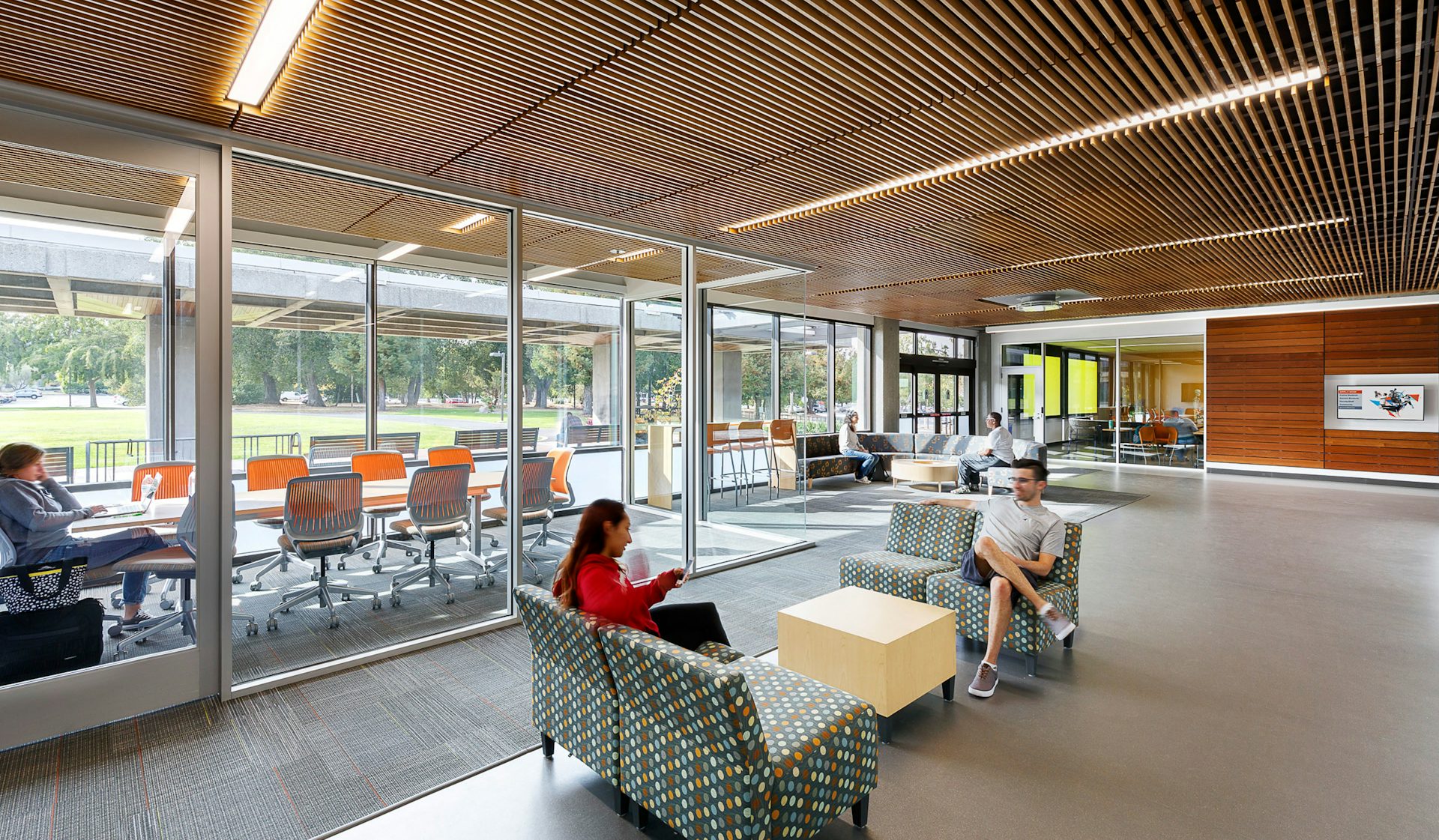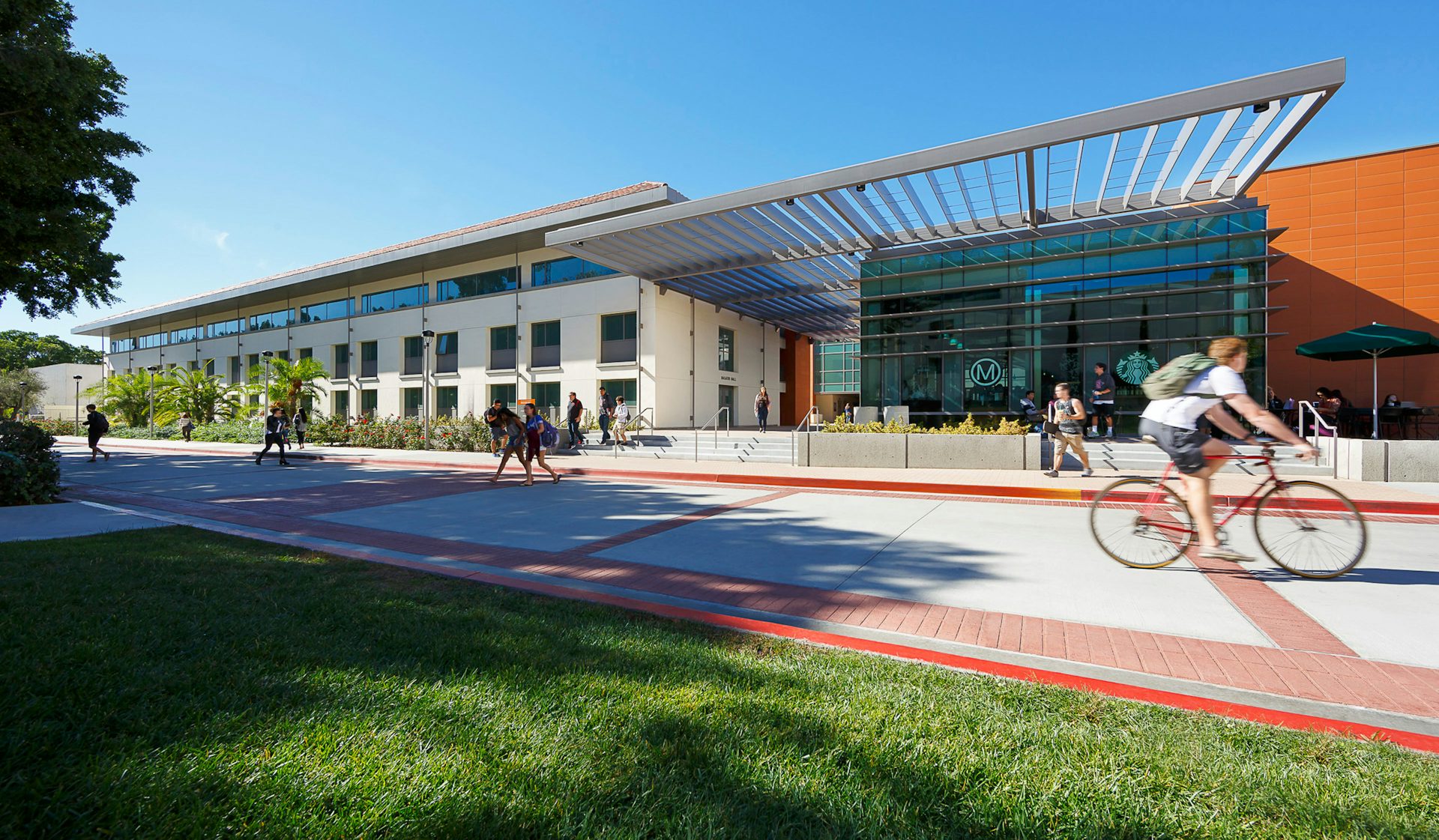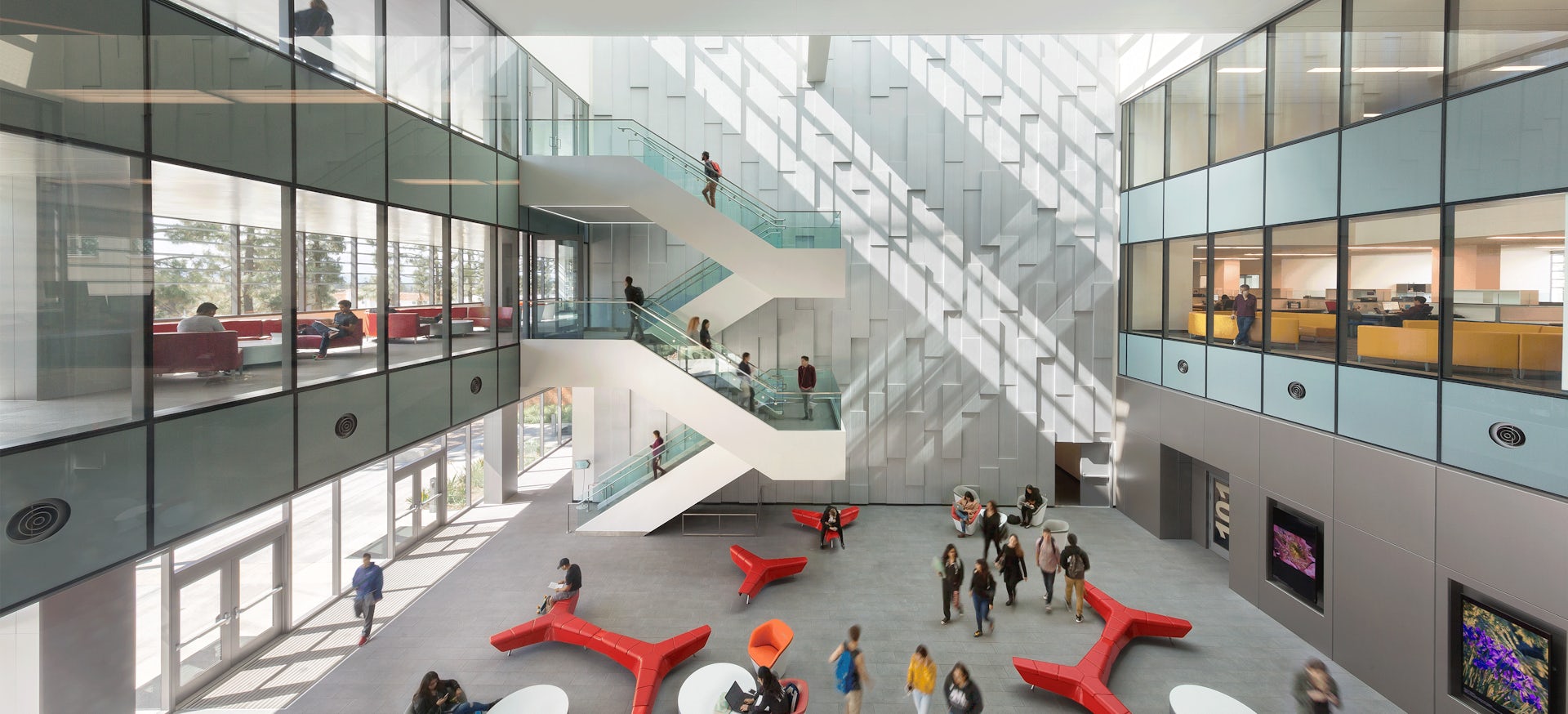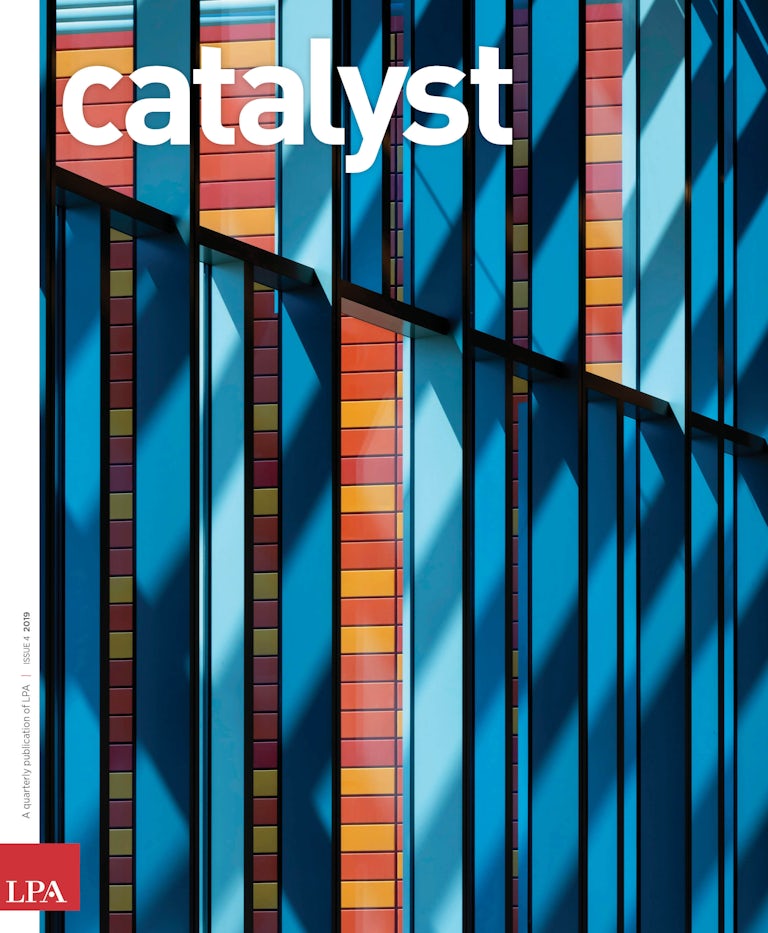A sea change is taking shape on campuses around the country as higher education administrators rethink how they organize, plan, use and operate their facilities to appeal to a more diverse generation of students. This paradigm is creating an opportunity for architects and designers to challenge traditional institutional models. Instructional spaces, student services, student unions, recreation facilities and libraries are being reimagined to better serve mid-career learners, international students, working adults and veterans, as campuses evolve into destinations for lifelong learning.
“Colleges and universities are educating and engaging students in different ways than in the past,” says Winston Bao, LPA Director of Higher Education Programming + Furniture Services. “Campuses must tailor the educational experience for a broad and diverse audience, and ensure that these environments can meet the needs of the ever-changing student population.”
These converging social and demographic shifts are happening amid an increasingly competitive educational environment, as pressure mounts on campuses to attract, retain and graduate students. Administrators are constantly expanding what defines a student and broadening their assumptions about what those potential students might want and need from a place of higher learning. All of this requires a more comprehensive approach to and understanding of campus design to assure educators and students have the necessary tools, services and environments to support their unique goals.
Staying Competitive
Educators and designers are working together to reshape college and university campuses for a new generation of students.
New Types of Classrooms
Antiquated notions of static classroom arrangements and non-descript lecture halls no longer work. They’ve been replaced with blended learning environments that include entrepreneur-focused maker spaces and open drop-in collaborative settings that can be actively transformed—through movable demising walls, sliding glass doors and windows, agile furnishings and other elements—into truly flexible educational environments.
“Today’s students are looking for inspiring educational spaces, first and foremost,” says LPA Director of Higher Education Steve Flanagan. Open and collaborative spaces close to classrooms are key elements of the West Valley College Cilker School of Art and Design in Saratoga, California, where LPA worked to convert a cold, dark and dreary 1960s classroom building with “good bones” into a state-of-the-art learning facility. Most of the solid interior and exterior walls were replaced with floor-to-ceiling glass, opening the classrooms and studios to student circulation and public interior spaces, as well as natural light from the exterior.
The project’s focus on borrowed daylight and transparency required the designers to carve out large areas from the existing building that were turned into spaces for gatherings, study groups and impromptu group presentations. The design also brings modernized classrooms and technology infrastructure to the complex, including improved spatial efficiencies and upgraded safety measures to comply with current building code and ADA standards. Projects like the Cilker School of Art and Design are effective on many levels when it comes to attracting and retaining new students, Flanagan says.
For one thing, the flexible learning spaces provide a counterpoint that prospective students can compare against classrooms on other campuses. And adaptive reuse projects can also save universities money, in contrast to costly and environmentally destructive demolition projects. The end result allows a university to retain its workhorse buildings without sacrificing the ability to stay up-to-date with necessary technology and safety enhancements.

The Corporate Influence
For many adult learners, especially those with career experience, design can be an important consideration when choosing an educational program. Many of LPA’s designs for university spaces are gleaning strategies from the corporate marketplace, including collaborative open office and co-working amenities and flexible furniture solutions. Students, like employees, are looking for one-of-a-kind amenities, while administrators are hoping they stay on campus longer to enrich their higher education experience.
Facilities that have incorporated group breakout areas or “sticky spaces” between formal learning spaces might look more like a collaborative workplace setting or lounge on a corporate campus. Examples can be found in the recently completed Center for Global Innovation at California State University, San Bernardino, which fulfills a wide range of needs for international students. For these students, a “home away from home” takes on a different meaning as designers look for opportunities to create environments for authentic connections—both with other students and the institution. These amenities may also take the form of a recreation or wellness center that focuses on helping students find balance in their busy schedules and lives.
“Like businesses, collegiate institutions want facilities that help attract the best students, faculty and staff,” Flanagan says. “This trend is pushing both universities and the workforce to improve facilities in more qualitative ways.”

Learning Beyond the Classroom
In this new, competitive era, meeting the educational and social needs of diverse groups of students necessitates open, multi-faceted campuses, Bao says. This holistic, open-ended approach positions today’s college campuses as small-scaled autonomous ecosystems, where classrooms, athletics, wellness, social hubs, housing and nature make up parts of a highly specialized community. LPA’s education team continuously relies on research and the design inquiry process to better understand students’ social, civic and recreational needs, in addition to the required educational benchmarks.
“Learning happens everywhere, not just in the classroom,” Bao says. “We’re creating theaters of learning, where spaces are welcoming atmospheres that optimize the built and natural environment to set the stage for healthy and inclusive student lifestyles.”
In contrast to more conventional higher education campus designs, where individual elements like academic departments, student services and social areas are typically siloed, the new generation of students prefers building complexes that serve multiple purposes. For example, diverse disciplines such as STEAM complexes are co-located to optimize collaboration and celebrate interdisciplinary learning that can often build innovative academic communities.
It’s also a fact that health and well-being play a critical role in supporting student success. The LPA-designed Oasis Wellness Center for California State University, Northridge was created to specifically address stress and sleep deprivation, which research identified as major obstacles to academic achievement. The student-led and student-funded project has changed the atmosphere on campus, logging more than 400 visits on peak days and more than 2,500 reservations a semester to use nap pods.

The Indoor-Outdoor Connection
Campuses today are being expanded to include a purposeful and transformative relationship with nature and the outdoors, part of an overall strategy that goes beyond the classroom experience. The goal is to make students’ time on campus more meaningful, especially older students who may be balancing a wide variety of roles and responsibilities. On many commuter campuses, students study or eat in their cars or leave the campus entirely in search of services that could be conveniently provided on campus.
In a project for American Career College, LPA introduced a student quad into the middle of a two-story structure. The interior quad is further accented with artificial turf carpet inlay and is populated by a series of brightly colored circular sofas and tables. The design came out of a desire to give students, largely working professionals who commute to campus, a space to study, hang out while they wait for classes or socialize with other students. The effect on the college was transformative both in student enrollment and retention, which saw sizable boosts after the campus opened.
“By putting a campus quad at the center of the building, we added a symbolic element to a non-traditional campus type that helps inspire students and faculty alike,” Flanagan says.
“In fact, faculty applications and retention spiked after the facility was opened. People were literally pulling off the freeway asking how they can work at American Career College.”

Outdoor spaces often perform multiple social, extracurricular and classroom roles on campuses. For San Diego State University’s Storm and Nasatir Halls, for example, LPA transformed a pair of outdated and neglected buildings by adding open-air plazas and a solar-panel-canopy-topped roof terrace with ocean views, in addition to new lecture halls and a new convenience store.
With students balancing jobs, in addition to their classroom coursework, campuses are striving to imbue their facilities with spaces and amenities that nurture as well as educate their student bodies, says LPA Landscape Project Designer Lancelot Hunter. That approach is on display at Palomar College’s new Learning Resource Center, where LPA crafted an 85,000-square-foot nucleus for the campus that maintains direct visual connections to the outdoors and is surrounded by a collection of thoughtful outdoor plazas and planted areas.
Studies show students succeed when comprehensive cultural educational experiences complement academic learning. The results are higher retention rates, better academic performance and happier students.
“We’re designing spaces that facilitate the growth of the individual,” Hunter says, “spaces that help create environments that make students feel more connected, and spaces that celebrate the experience of being a student.”
This story originally appeared in Catalyst Issue 4 2019. Subscribe today to receive Catalyst, a quarterly publication that takes a deep dive into design ideas, industry leaders and initiatives.















